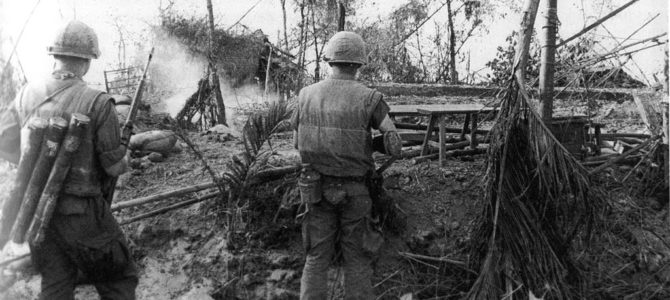
Fifty years ago, American Marines were wrapping up their bloody battle to retake the historic Vietnamese capital of Hue, occupied by communist forces in the Tet Offensive weeks before.
Graphic images from the struggle went on display in January at the Newseum, in Washington DC, in an exhibit titled, “The Marines and Tet: The Battle That Changed the Vietnam War.” The title of the exhibit, which runs through July 8, is borrowed from iconic newsman Walter Cronkite. Coverage of Tet, he said, “changed how people looked at the war, and in doing so, it changed the war itself.”
Tet turned out to be a terrible communist defeat. But at the time, America saw only carnage presented by American media. One startling photo in the Newseum exhibit shows dead and injured Marines stacked for evacuation on an American tank, one soldier tilted up painfully on his side for a sucking chest wound, the scene all ragged uniforms and soiled medical dressings and redolent of defeat.
There was also the nightmarishly graphic street execution of a Viet Cong fighter in Saigon, and bloody photos of dead guerillas in the U.S. embassy. I remember seeing these in full-color in Time magazine, scarlet blood staining the green lawn of the embassy courtyard. It convinced an already war-weary American public that this war just couldn’t be won.
They were helped to that pessimistic conclusion by Cronkite. “To say that we are closer to victory today is to believe, in the face of the evidence, the optimists who have been wrong in the past,” he regretfully intoned. “To say that we are mired in a bloody stalemate seems the only realistic, yet unsatisfactory conclusion.”
We’re Still Fighting a 1960s War
Another conflict from that era is still being fought, Lyndon Johnson’s War on Poverty. But no one in the press is playing a modern-day Cronkite, regretfully announcing stalemate and the need to withdraw and cut our losses. On the contrary, a Politico adaptation of a new book, “Building the Great Society: Inside Lyndon Johnson’s White House,” by Joshua Zeitz, suggests that failure so far just means we need to fight harder.
It’s an idea that will resonate in certain circles. But to engage in a bit of counterfactual history, what chance would the idea have if American reporters had covered these decades of Johnson’s War on Poverty with the same skepticism they brought to fighting in Vietnam?
Both Vietnam and the War on Poverty were more successful than portrayed, but the aim then and now was and is different. The impression of failure in Vietnam was intended to end the war; in the War on Poverty, the goal is escalation.
The Tet Offensive cost the enemy close to 50,000 fighters and untold amounts of equipment and supplies. It is now considered a huge victory for American and South Vietnamese forces that left the communists all but unable to carry on the fight. After the enemy was driven out of Hue, mass graves were found containing thousands of civilians—male and female, adults and children—the communists executed for cooperating with the Saigon government.
Properly reported, the massacre could have buttressed the understanding that American success was forcing the enemy into desperately cruel measures. Instead, the American press arrived at exactly the opposite conclusion: we were the spent force, and it was time to cut our losses and abandon the struggle. The massacre went largely unreported. Even today, some insist no more than 700 Hue functionaries were executed, the rest of the victims dying in American bombardments.
Doubling Down on Failure
Imagine if the ambiguous result in our long struggle to end poverty—like the Vietnam War, an effort in which the goal posts always seem to be moving—was shown to be as ineffective. It seems unlikely it would convince our modern-day poverty hawks that a whole new approach is needed.
“Democrats today are revisiting some of the ideas that Johnson’s White House considered but ultimately rejected,” Zeitz says, including a guaranteed family income (which Hillary Clinton wrote in her campaign memoir that she nearly adopted), and single-payer if not universal health care. This contrasts with the early Great Society’s explicitly stated “opportunity theory” approach that focused on giving people life-improving skills rather than simply handing out money.
America’s poverty remediation efforts have had positive effects. A Heritage Foundation report in 2015 cited a study by scholars Irwin Garfinkel, Lee Rainwater, and Timothy Smeeding—no conservatives—concluding that, comparing apples to apples, “social welfare spending per capita in the U.S. rises to nearly twice the European average.”
Zeitz also acknowledges some success in the War on Poverty, but mostly in the early phases. “When economists factor in noncash assistance including food stamps, Medicaid and housing subsidies,” as well as the earned income tax credit, “the poverty rate fell by 26 percent between 1960 and 2010, with two-thirds of the decline occurring before 1980,” he writes.
Early Positive Coverage Diverges
It was much the same in the Vietnam War, including early victories like the hard-fought 1965 Battle of the Ia Drang Valley (dramatized in the Mel Gibson movie, “We Were Soldiers Once, and Young”), which soundly defeated an enemy force foolish enough to meet American troops head on. They rarely made that mistake thereafter.
Early coverage was much more positive. American reporters were willing to use phrases like “communist aggression,” and wrote stories about southern forces standing up to ruthless invaders from the north. Even National Geographic ran features on Special Forces “A-teams” of advisors working with South Vietnamese fighters, including an article that had grizzled Green Berets stripping to don the loin-cloth and headdress ceremonial garb of Montagnard tribesmen to solidify a unified fighting spirit.
But as the enemy’s reluctance to face destruction in set-piece battles turned the war into a hard-to-measure grind, with its attendant effect on morale and military discipline. Reporters vied to get the latest disarray-among-the-troops scoop. By 1968, stories were focusing on drugs, racial friction among the troops, and “fragging” of officers, and Americans watched a succession of young soldiers, embittered by watching their friends die with little apparent success to show for it, stare with haunted eyes into the camera and confess they just didn’t know why they were there.
The sluggish pace of insurgency pacification and the military’s baffled cupidity, including the ghoulish daily “body count” that formed its only concrete measure of success, eventually compressed into one bloody-stage Marx’s dictum (Karl, not Groucho) that history rolls by first as tragedy then as farce. Associated Press Saigon Bureau Chief Richard Pyle eventually described the daily military briefings as “the longest-playing tragicomedy in Southeast Asia’s theater of the absurd.”
What if reporters were as openly dismissive in probing Great Society programs? Of course, the Vietnam War piled up a very real body count, so perhaps it’s not quite fair to expect the press to respond as aggressively in the case of the War on Poverty, which was never a real shooting war. But that only goes so far in explaining the disparity in coverage. It seems fair to suggest they were also just more disposed to accept the government’s definition and examples of success for ideological reasons. There is rarely a shortage of support in the media for activist government, at least domestically.
A Case of Domestic Carnage
America might now look very different had reporters taken seriously the profound damage welfare rules caused by helping to drive fathers from American homes. Single-parent families were at 12 percent in 1960 and are 31 percent now, with all the attendant social disintegration that causes.
Imagine if mainstream reporters had uncovered more stories like the one recently in National Review that found Democratic state administrations abetting government employee unions in harvesting Medicaid funds (and membership dues) by forcing people into state-employee status merely because they received tax dollars for taking care of disabled family members.
Would The New York Times bravely publish the “Poverty Papers”: leaked government reports showing that Housing and Urban Development-associated entities failed to enforce the required hiring of low-income workers, costing billions of HUD tax dollars? Coverage like that might well sour Americans on opening new fronts in the War on Poverty.
Zeitz sounds a surprisingly Cronkite-ian note. “Since the 1970s the Great Society has drawn sharp criticism for what it did not do,” he writes. “It did not succeed in its ambition to eliminate poverty. It did not effect wide-scale cash transfers or establish a minimum family income. It did not extend quality medical care and educational opportunity to all Americans. It did not save urban America from blight or depressed rural areas from further decline.”
But instead of calling the troops home, he recommends an even more aggressive approach. “Opportunity theory just might be inadequate for the 21st century American economy,” he writes. “Government must rethink how it extends basic economic security – and with it, food and health security … It’s now been a half century since (Johnson) bequeathed us the Great Society, and these same challenges are as urgent as ever before.”
Double down and call for more troops, in other words, essentially what Gen. William Westmoreland was mocked for in the aftermath of Tet. That’s one way to go, but if we learned anything from the Vietnam War, digging harder is a poor way to get out of a hole.









